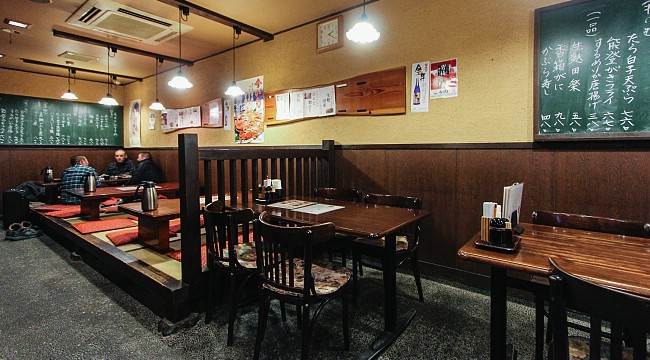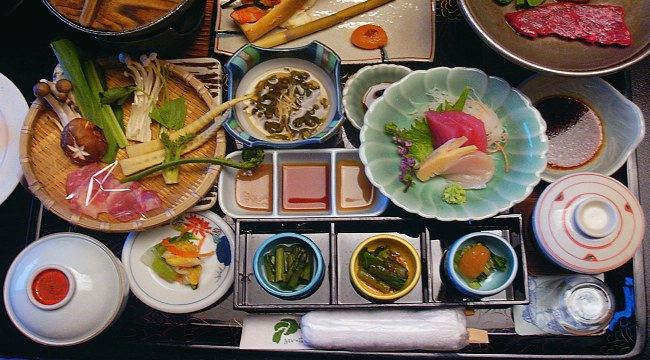Japanese Table Manners

Tables and Seating
Some restaurants in Japan have low tables and cushions on tatami floor instead of (or in addition to) Western style chairs and tables. Shoes and slippers have to be removed before stepping on tatami. Also, avoid stepping onto cushions other than your own. See our sitting page for more details about sitting techniques and rules.
Eating
Wet towels (oshibori) are provided at most restaurant to clean your hands before eating. After ordering, it is common to wait for everyone’s order and then to start the meal with the phrase “itadakimasu” (“I gratefully receive”). If a dish is better eaten right away but others at the table have not been served yet, the phrases “osaki ni dōzo” (“please go ahead”) or “osaki ni itadakimasu” (“allow me to start before you”) can be useful.
When eating from small bowls, it is correct manner to pick up the bowl with your hand and lead it close to your mouth when eating from it; however, larger types of dishes should generally not be picked up. When eating from shared dishes (as it is commonly done at some restaurants such as izakaya), it is polite to use the opposite end of your chopsticks or dedicated serving chopsticks for moving food.
Blowing your nose at the table, burping and audible munching are considered bad manners in Japan. On the other hand, it is considered good style to empty your dishes to the last grain of rice. If there are food items that you do not like or cannot eat, replacements may be available at restaurants or ryokan if you tell them in advance. Otherwise, it is advisable to leave the items on the dish.
After finishing your meal, it is generally good manner to return all your dishes to how they were at the start of the meal. This includes replacing the lids on dishes and putting your chopsticks back on the chopstick rest or in its paper holder. Conclude the meal with the phrase “gochisōsama deshita” (“thank you for the feast”) which includes gratitude not only towards the cook but also the ingredients consumed.

Drinking
Do not start drinking until everybody at the table has a drink and the glasses are raised for a drinking salute, which usually is “kampai“.
When drinking alcoholic beverages, it is customary to serve each other, rather than pour your own drink. Periodically check your friends’ cups and refill their drinks if their cups are getting empty. Likewise, if someone wants to serve you more alcohol, you should drink some from your glass before holding it towards that person.
While it is considered bad manners to become obviously drunk in some formal restaurants, for example high-end restaurants that serve kaiseki ryori (Japanese haute cuisine), the same is not true for other types of restaurants such as izakaya, as long as you do not bother other guests.
If you do not drink alcohol, it is not impolite to say so and request for other beverages instead. Non-alcoholic beverages that are usually available include alcohol-free beer, tea, juices and carbonated drinks.
How to eat…

… rice
Hold the rice bowl in one hand and the chopsticks in the other. Lift the bowl towards your mouth while eating. Do not pour soy sauce over white, cooked rice.

.. sushi
Pour some soy sauce into the small dish provided. It is considered bad manners to waste soy sauce, so try not to pour more sauce than you will be using.
You do not need to add wasabi into the soy sauce, as sushi pieces that go well with wasabi will contain it already. However, if you choose to add wasabi, use only a small amount so as not to offend the sushi chef. If you do not like wasabi, you can request that none is added into your sushi.
In general, you are supposed to eat a sushi piece in one bite. Attempts to separate a piece into two generally end in the destruction of the beautifully prepared sushi. Hands or chopsticks can be used to eat sushi.
In case of nigiri-zushi, dip the piece into the soy sauce upside-down so that the fish enters the sauce. A few kinds of nigiri-zushi, for example, marinated pieces, should not be dipped into soy sauce.
In case of gunkan-zushi, pour a small amount of soy sauce over the sushi piece rather than dipping it into the sauce.

… sashimi
Pour some soy sauce into the small dish provided. Put some wasabi on the sashimi piece, but be careful not to use too much as this will overpower the taste of the fish. Dip the sashimi pieces into the soy sauce. Some types of sashimi are enjoyed with ground ginger rather than wasabi.

… miso soup
Drink the miso soup out of the bowl as if it were a cup, and fish out the solid food pieces with your chopsticks.

… noodles
Using your chopsticks, lead the noodles into your mouth. You may want to try to copy the slurping sound of people around you if you are dining in a noodle shop. Rather than being bad manner, slurping noodles is considered evidence of enjoying the meal and enhances the flavor.
In case of noodle soups, be careful of splashing the noodles back into the liquid. If a ceramic spoon is provided, use it to drink the soup; otherwise, lift the bowl to your mouth and drink from it directly.

… curry rice (and other rice dishes with a sauce)
Japanese curry rice and other rice dishes, in which the rice is mixed with a sauce (for example, some domburi dishes) can be difficult to eat with chopsticks. Large spoons are often provided for these dishes, instead.

.. big pieces of food (e.g. prawn tempura, tofu)
Separate into bite sized pieces with your chopsticks (this takes some practice), or just bite off a piece and put the rest back onto your plate.

